#Herbig-Haro 46/47 by Webb Telescope
Explore tagged Tumblr posts
Text

Herbig-Haro 46/47 by Webb Telescope
NASA’s James Webb Space Telescope has captured a tightly bound pair of actively forming stars, known as Herbig-Haro 46/47, in high-resolution near-infrared light. Look for them at the center of the red diffraction spikes, appearing as an orange-white splotch. Herbig-Haro 46/47 is an important object to study because it is relatively young – only a few thousand years old. Star systems take millions of years to fully form. Targets like this give researchers insight into how much mass stars gather over time, potentially allowing them to model how our own Sun, which is a low-mass star, formed – along with its planetary system.
Credits: Image: NASA, ESA, CSA. Image Processing: Joseph DePasquale (STScI).
#Herbig-Haro 46/47 by Webb Telescope#james webb telescope#james webb photos#james webb images#nasa#nasa picture of the day#space#stars
28 notes
·
View notes
Text
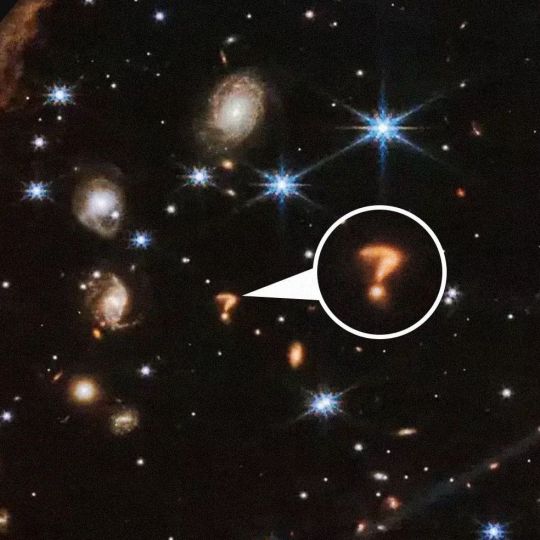

Cosmic Question Mark !
In a discovery that seems almost too perfect to be true, NASA’s James Webb Space Telescope has captured an image of a cosmic question mark. The strange phenomenon is, according to scientists, the result of the interaction of two galaxies.
The cosmic question mark is actually a part of a larger image. Webb recently captured the intricate dance of a pair of young stars, known as Herbig-Haro 46/47, through advanced near-infrared imaging.
The curious nickname of the image comes from the unusual shape of the galaxies, which seems to take the form of a question mark in our visual perception. They are actually two separate galaxies, engaged in a gravitational interaction that distorts their shape and modifies their trajectory.
Courtesy: Nasa
#art#cosmos#cosmic#universe#blast#photography#stars#question mark#surreal#nasa#james webb space telescope#galaxies#herbig-haro 46/47#infrated#gravity
253 notes
·
View notes
Text




?
#jwst#james webb space telescope#herbig-haro 46/47#?#bok globule#gum nebula#vela and puppis constellations
27 notes
·
View notes
Text
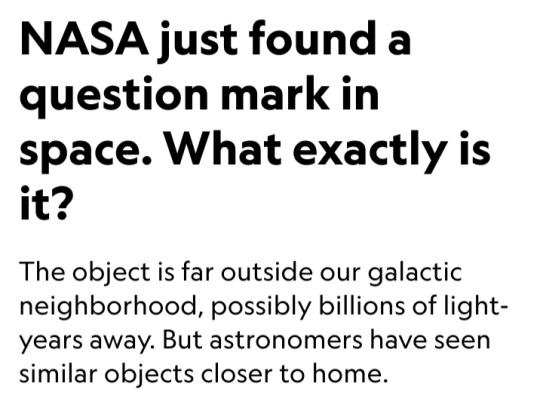
By Allie Yang
10 August 2023

Two of our galaxy’s most famous stars were recently photobombed by what appears to be a celestial question mark.
The symbol was spotted in a new image from the James Webb Space Telescope (JWST) of the forming stars Herbig-Haro 46/47, which are well-known and have been frequently observed by astronomers.
These two stars can provide clues about how our own sun may have formed.
They’re relatively close to Earth, about 1,400 light-years, and relatively young, only a few thousand years old.
In fact, they’re still in gestation and have not technically been “born” yet, which is marked when the stars start shining from their own nuclear fusion.
The image is the first of the twin protostars from the NIRCam instrument on JWST.
It was captured using infrared light, which penetrates space dust more easily than visual light, and it is the highest resolution image of the objects ever seen at these wavelengths.
The telescope’s astonishing sensitivity allowed the glowing red question mark to be captured in the lower center of the image.
The object is far outside our galactic neighborhood, possibly billions of light-years away, says Christopher Britt, an education and outreach scientist at the Space Telescope Science Institute who helped plan these observations.
His best guess is that the question mark is actually two galaxies merging.
“That's something that's seen fairly frequently, and it happens to galaxies many times over the course of their lives,” he says.
“That includes our own galaxy, the Milky Way … [it] will merge with Andromeda in about four billion years or so.”
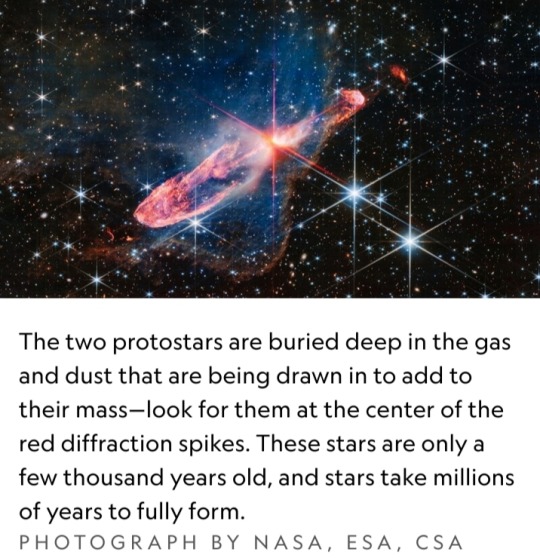
The hints pointing to two galaxies are found in the question mark’s strange shape.
There are two brighter spots, one in the curve and the other in the dot, which could be the galactic nuclei, or the centers of the galaxies, Britt says.
The curve of the question mark might be the “tails” being stripped off as the two galaxies spiral toward each other.
“It's very cute. It's a question mark … But you can find the colons and semicolons, and any other punctuation mark, because you have 10,000 little smudges of light in each image taken every half hour,” says David Helfand, an astronomer at Columbia University.
The sheer number of shining objects we find are bound to create some serendipitous images, and our brains have evolved to find those patterns, he says.
Astronomers have seen similar objects closer to home.
Two merging galaxies captured by the Hubble Space Telescope in 2008 also look like a question mark, just turned 90 degrees.
Helfand says the question mark seems to be two objects, the curve and the dot, but could be more that just happened to line up.
They could also be completely unrelated objects, he says, if one is much closer to Earth than the other.
Britt warns that estimating distance based only on colors in the image can be tricky.
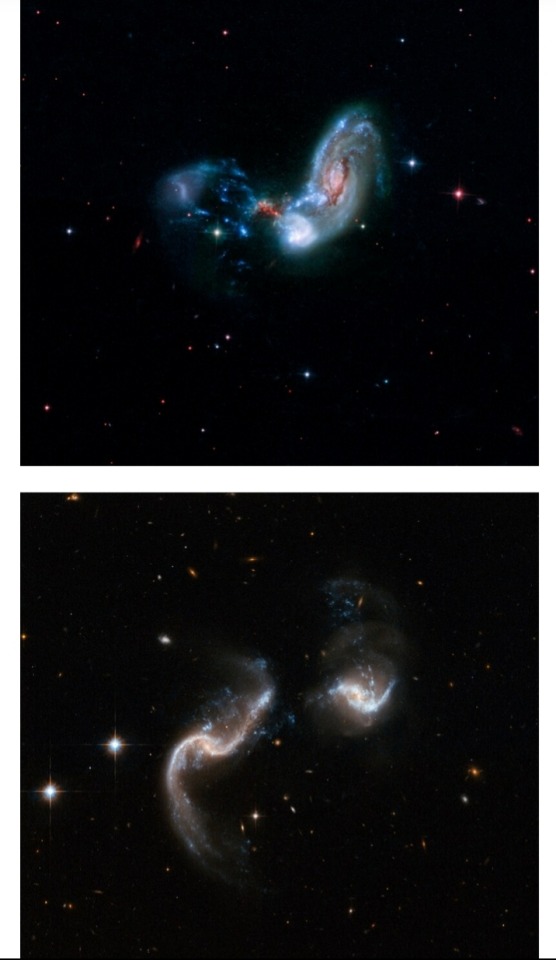
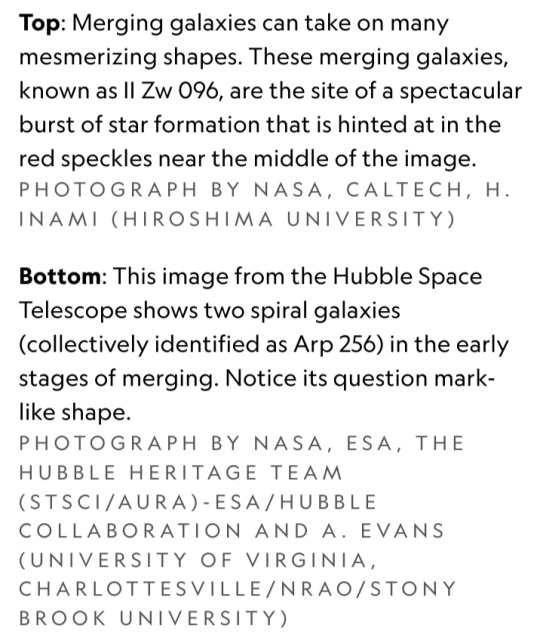
The red of the question mark could mean it’s very far away (light waves stretch as they travel through the expanding universe, shifting to redder wavelengths) or that it’s closer and obscured by dust near the object.
It would take more investigation to identify exactly how far away the question mark is.
This could be done by measuring photometric redshifts, determined by the brightness observed through different filters, but this would only provide an estimate for the distance, Britt says.
Spectroscopy, which analyzes light from the source to determine its elemental makeup, could provide a more exact distance but requires a separate instrument to measure.
Given the number of intriguing targets spotted by JWST, the question mark may never receive this treatment.
For now, the source of this symbol in the sky remains a cosmic mystery.
#James Webb Space Telescope (JWST)#celestial question mark#stars#galaxy#space#astronomy#Herbig-Haro 46/47#NIRCam#infrared light#protostars#Christopher Britt#Space Telescope Science Institute#galactic nuclei#astronomers#Hubble Space Telescope#photometric redshifts#Spectroscopy#cosmic mystery#National Geographic#Nat Geo#NASA
9 notes
·
View notes
Text

An image captured by the James Webb Space Telescope portrays Herbig-Haro 46/47, or simply HH 46/47, a nebula of ionized gas that emits a faint light in which two lobes are very bright instead. The two numbers are due to the fact that there are two young stars still growing in the middle of a disk of gas and dust. Webb's NIRCam (Near-Infrared Camera) instrument captured details of that area never seen before. The nebula is invisible at optical frequencies and is blue at infrared. The most spectacular part is the one characteristic of the Herbig-Haro objects with the ionized stellar winds forming two lobes visible in the image in orange hues.
4 notes
·
View notes
Text



Can you find the question mark?



#reblog#astronomy#james webb space telescope#hh 46/47#herbig-haro objects#protostsrs#star formation#vela#merging galaxies#?#question mark
167 notes
·
View notes
Text
James Webb Space Telescope captures stunning images of actively forming stars
James Webb Space Telescope captures stunning images of actively forming stars
James Webb Space Telescope captures stunning images of actively forming stars. The James Webb Space Telescope has captured a stunning new image of two actively forming stars, collectively known as Herbig-Haro 46/47. The image shows the stars embedded in a disc of gas and dust, about 1,400 light-years away from Earth. James Webb Space Telescope has just captured a new image of actively forming…
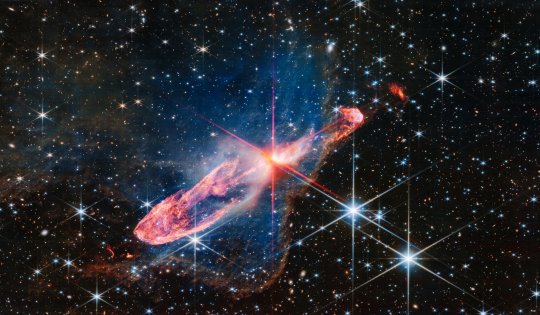
View On WordPress
#000 years old#1#100#400 light-years away#accreting#amazing images#bow shock#Herbig-Haro 46/47#Herbig-Haro object#James Webb Space Telescope#natal cocoon#Near-Infrared Camera (NIRCam)#power of JWST#revolutionize our understanding of star formation#star formation#stunning image
1 note
·
View note
Text
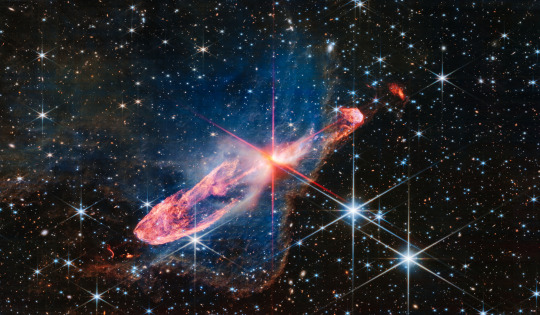
NASA’s James Webb Space Telescope has captured a tightly bound pair of actively forming stars, known as Herbig-Haro 46/47, in high-resolution near-infrared light. Look for them at the center of the red diffraction spikes, appearing as an orange-white splotch. Herbig-Haro 46/47 is an important object to study because it is relatively young – only a few thousand years old. Star systems take millions of years to fully form. Targets like this give researchers insight into how much mass stars gather over time, potentially allowing them to model how our own Sun, which is a low-mass star, formed – along with its planetary system.
Credits: Image: NASA, ESA, CSA. Image Processing: Joseph DePasquale (STScI)
1K notes
·
View notes
Photo

2023 July 28
Young Stars, Stellar Jets Image Credit: NASA, ESA, CSA, Processing: Joseph DePasquale (STScI)
Explanation: High-speed outflows of molecular gas from a pair of actively forming young stars shine in infrared light, revealing themselves in this NIRcam image from the James Webb Space Telescope. Cataloged as HH (Herbig-Haro) 46/47, the young stars are lodged within a dark nebula that is largely opaque when viewed in visible light. The pair lie at the center of the prominent reddish diffraction spikes in the NIRcam image. Their energetic stellar jets extend for nearly a light-year, burrowing into the dark interstellar material. A tantalizing object to explore with Webb's infrared capabilities, this young star system is relatively nearby, located only some 1,140 light-years distant in the nautical constellation Vela.
∞ Source: apod.nasa.gov/apod/ap230728.html
217 notes
·
View notes
Text

NASA's Webb Telescope has captured the 'antics' of a pair of actively forming young stars, known as Herbig-Haro 46/47, This is the most detailed portrait of these stars, which reside only 1470 light-years away in the constellation Vela, to date.
Read more: https://rb.gy/dnskn
#james webb images#james webb update#james webb uzay teleskobu#james webb space telescope#james webb space technology#james webb telescope#james webb photos
65 notes
·
View notes
Text

Herbig-Haro 46/47, James Webb Telescope (2023)

Access Cover in Greater London, my phone camera (2023)
68 notes
·
View notes
Text

A near-infrared light image made by the James Webb Space Telescope of actively forming stars, known as Herbig-Haro 46/47, had at the bottom of the frame an apparent question mark.Credit…NASA, ESA, CSA, Joseph DePasquale (STScI), Anton M. Koekemoer (STScI)
15 notes
·
View notes
Photo

James Webb Space Telescope spies cosmic question mark in deep space | Space
When looking for answers in the cosmos, sometimes more questions appear
The James Webb Space Telescope continues to provide answers about the earliest days of the universe, but it's also discovering more questions.
Question marks, to be precise. The James Webb Space Telescope (JWST) team at the European Space Agency (ESA) released an image on Wednesday (June 26) offering the most detailed look yet at two actively forming young stars located 1,470 light-years from Earth in the Vela Constellation. In the image, the stars, named Herbig-Haro 46/47, are surrounded by a disk of material that "feeds" the stars as they grow for millions of years.
But just below those stars, in the background of the stunning deep-space image, is an object resembling a giant cosmic question mark. Is the universe asking us something? ...
9 notes
·
View notes
Text
The James Webb telescope took a detailed image of the Herbig-Haro 46/47 star system, 1470 light-years away from us. And in this frame, scientists noticed a giant question mark, presumably the interaction of two galaxies.

Photo: NASA/ESA/CSA James Webb Space Telescope
15 notes
·
View notes
Text
The Year’s Most Spectacular Photos from the James Webb Telescope
By Jeffrey Kluger
December 22, 2023

Close to 1,500 light years from Earth lie a pair of baby stellar twins known as Herbig-Haro 46/47 — which are barely a few thousand years old.
A star the size of our sun, by contrast, takes an average of 50 million years to reach even the stellar equivalent of young adulthood It's Herbig-Haro 46/47's extreme youth that gives the formation more of a blob-like appearance than the stellar duo it is.
Young stars are buried in clouds of dust and gas, which they absorb as they grow. Sometimes, however the infant stars ingest too much material too fast.
When that happens, dust and gas erupts from both sides of the formation, giving the young pair their misshapen look.
But if you have patience — 50 million years worth of patience — what is a blob today will be stars tomorrow.
NASA, ESA, CSA. Image Processing: Joseph DePasquale (STScI)
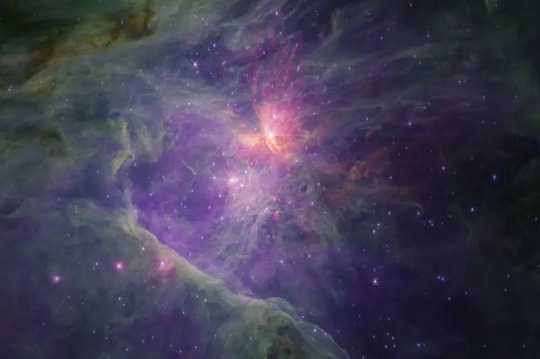
A pair of brilliant stellar nurseries located 1,600 light years from Earth, the Orion Nebula and Trapezium Cluster are home to a relative handful of very young but very bright stars.
Four of the stars are easy to see with a simple, amateur, four-inch telescope.
One of the four — the beast of the young litter — is especially visible, a full 20,000 times brighter than our sun.
Apart from their four main stars, the Orion Nebula and Trapezium cluster contain approximately 700 additional young stars at various stages of gestation.
NASA, ESA, CSA/Science leads and image processing: M. McCaughrean, S. Pearson, CC BY-SA 3.0 IGO

(L): It’s not easy being a Wolf-Rayet star, like this specimen imaged by the Webb telescope at a distance of 15,000 light years.
A rare species of stellar beast — NASA estimates there are only 220 of them in a Milky Way galaxy with at least 100 billion stars — the Wolf-Rayet burns hot and burns fast, with temperatures 20 to 40 times the surface of the sun.
All of that rapidly expended energy causes the star to lose its hydrogen envelope quickly and expose its helium core.
The result: a very early and very violent death.
A star like our sun burns for about 10 billion years. As for a Wolf-Rayet? Just a few hundred thousand before it dissolves into cosmic dust.
NASA, ESA, CSA, STScI, Webb ERO Production Team
(R): If the Wolf-Rayet star dies an ugly and violent death, the celebrated Ring Nebula, photographed by the Webb at a distance of 2,000 light years from Earth, has been expiring beautifully.
The glowing remains of a sun-like star, the nebula was discovered in 1779 by the French astronomer Antoine Darquier de Pellepoix.
As the nebula throws off its outer layers of ionized gas, it reveals its characteristic blue interior, composed of hydrogen and oxygen that have not yet been expelled off by the nebula’s stellar wind.
ESA/Webb, NASA, CSA, M. Barlow (University College London), N. Cox (ACRI-ST), R. Wesson (Cardiff University)
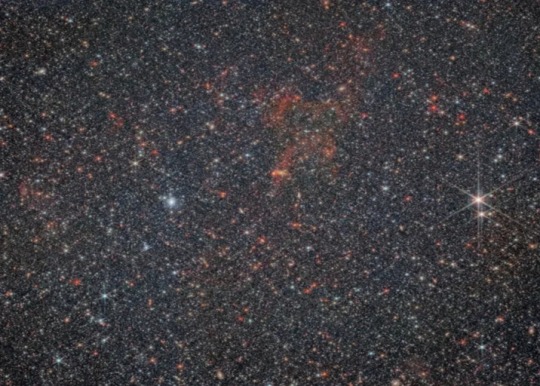
Dwarf galaxy NGC 6822 lives up to to its name — home to just 10 million stars, compared to the minimum of 100 billion in the Milky Way.
But what NGC 6822 lacks in numbers, it makes up in spectacle — which the keen eye of the Webb telescope has revealed.
Discovered in 1884 by American astronomer E.E Barnard, NGC 6822, is now known to have a prodigious dust tail measuring 200 light years across..
What's more, it's home to a dense flock of stars that glow 100,000 times brighter than our sun.
ESA/Webb, NASA & CSA, M. Meixnev

Spiral galaxies are often defined by uneven — and even ragged — arms.
But not galaxy M51, which lies 27 million light years from Earth and is defined by the tautness of its arms and the compactness of its structure.
M51 isn't alone in space. Nearby lies the companion galaxy NGC 5195.
The two galaxies are engaged in something of a gravitational tug of war — one that the NGC 5195 is winning.
NGC's constant gravitational pull is thought to account for both the tightly woven structure of M51's arms and for tidal forces that are thought lead to the creation of new stars in the arms.
ESA/Webb, NASA & CSA, A. Adamo (Stockholm University) and the FEAST JWST team
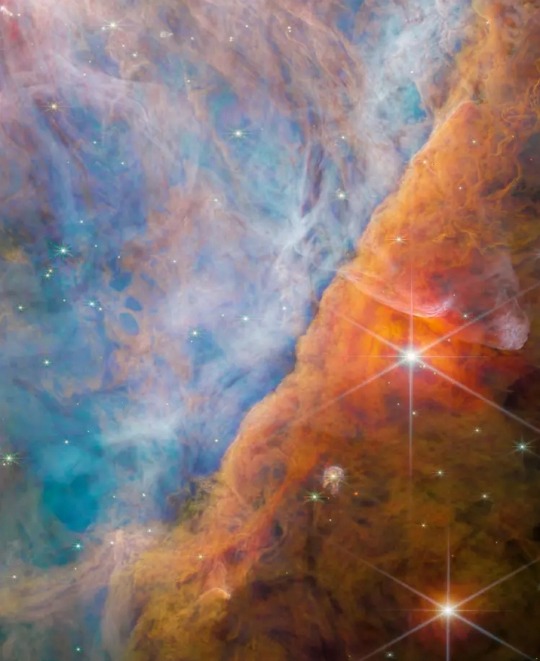
Just below Orion’s belt lies one of the most celebrated objects in the night sky: the Orion Nebula, a stellar nursery that is home to about 700 young stars.
This Webb image focuses not on the entirety of the nebula but on a structure in the lower left-hand quadrant known as the Orion Bar.
So named because of its diagonal, ridge-like appearance, the bar is shaped by the powerful radiation of the hot, young stars surrounding it.
ESA/Webb, NASA, CSA, M. Zamani (ESA/Webb), and the PDRs4All ERS Team

A baby by stellar standards, the IC 348 Star cluster is just five million years old and located about 1,000 light years from Earth.
Composed of an estimated 700 stars, IC 348 has a structure similar to wispy curtains, created by dust that reflects the light of the stars.
The conspicuous loop in the right hand side of the image is likely created by the gusting of solar winds blowing in the direction that, from Earth, would be west to east.
NASA, ESA, CSA, STScI, Kevin Luhman (PSU), Catarina Alves de Oliveira (ESA)
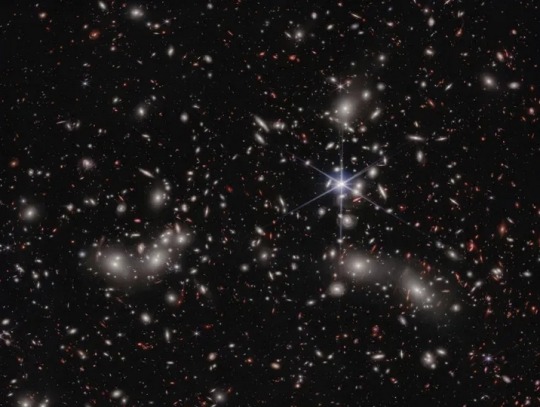
When it comes to galaxies, there's big and then there's huge and by any measure, Pandora's Cluster — more formally, known as Abell 2744 — qualifies as the latter.
Not just a galaxy, and not even a cluster of galaxies, Abell 2744 is a cluster of four clusters, which long ago collided with one another.
Located 3.5 billion light years from Earth, Pandora's Cluster measures a staggering 350 million years across.
The cluster's massive collective gravity allows astronomers to use it as a gravitational lens, bending and magnifying the light of foreground objects, making them easier to study.
NASA, ESA, CSA, I. Labbe (Swinburne University of Technology) and R. Bezanson (University of Pittsburgh). Image processing: Alyssa Pagan (STScI)

Webb was built principally to look at the oldest and most distant objects in the universe, some of 13.4 billion light years away.
But doesn't prevent the telescope from peering into its own back yard.
This image of Saturn and some of its 146 moons, rivals the images obtained by the Pioneer and Voyager probes.
NASA, ESA, CSA, STScI, Matt Tiscareno (SETI Institute), Matt Hedman (University of Idaho), Maryame El Moutamid (Cornell University), Mark Showalter (SETI Institute), Leigh Fletcher (University of Leicester), Heidi Hammel (AURA). Image processing: J. DePasquale (STScI)
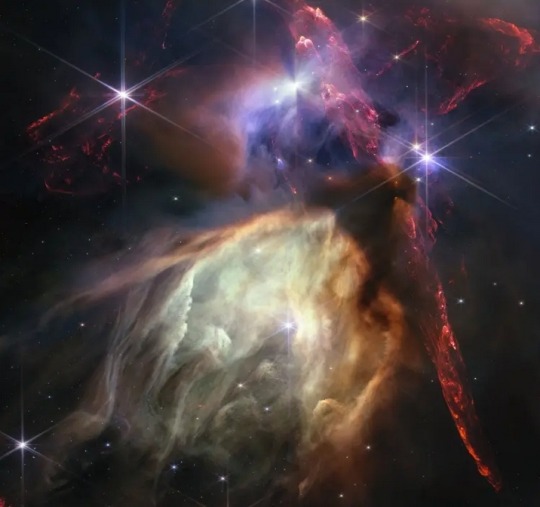
Infant stars are born all over the universe, but the closest stellar birthing suite to Earth is the Rho Ophiuchi cloud complex, located just 460 light years distant.
A turbulent — even violent — place, Rho Ophiuchi is defined by jets of gas roaring from young stars.
Most of the stars in this comparatively modest nursery are more or less the size of the sun.
But one, known as S1, is far bigger — so much so that it is self-immolating, carving a great cavity around itself with its stellar wind, the storm of charged particle's all stars emit, though few with the gale-force power of S1.
NASA, ESA, CSA, STScI, Klaus Pontoppidan (STScI)
#James Webb Telescope#James Webb Space Telescope#telescope#space#stars#galaxies#universe#cosmos#astronomy#space photography#photpgraphy#NASA#galactic clusters#milky way galaxy#Orion’s belt#Orion Nebula#Orion Bar#Pandora's Cluster#Saturn#Rho Ophiuchi cloud complex#Trapezium Cluster#Wolf-Rayet#Ring Nebula#Antoine Darquier de Pellepoix#E.E Barnard#spiral galaxy#nebula
112 notes
·
View notes
Text
Webb Telescope Witnesses Herbig-Haro 46/47's Fiery Dance of Stars and Nebulae. Read full article here

The cosmos never disappoints, and NASA's James Webb Space Telescope has just revealed a jaw-dropping sight - a stunning, high-resolution near-infrared image of the vibrant young stars, Herbig-Haro 46/47! 😍🌌
The fiery orange lobes gracefully fan out from the center of these stars, portraying their rambunctious nature. Can you believe they're just a few thousand years old? 🤯 This golden opportunity allows researchers to understand how stars like our very own Sun gather mass over time, unlocking cosmic secrets! 🔭
A mesmerizing nebula, shrouded in a soft blue haze, surrounds the stars, shaping their celestial dance! ✨ The spectacular ejections of gas and dust add a magical touch to the cosmic symphony, creating ever-changing patterns like a celestial fountain. 🌌
And let's not forget the delightful asymmetry - wispy blobs and intriguing arcs that make this cosmic story even more captivating! 🌀
With each passing moment, the James Webb Telescope unravels profound insights into star formation, deepening our connection to the universe's grand narrative! 🌠💫
So, prepare to be amazed as Herbig-Haro 46/47 takes you on a cosmic journey that will leave you in awe! 🚀🌟
Download James Webb Discovery App from www.jameswebbdiscovery.com

10 notes
·
View notes